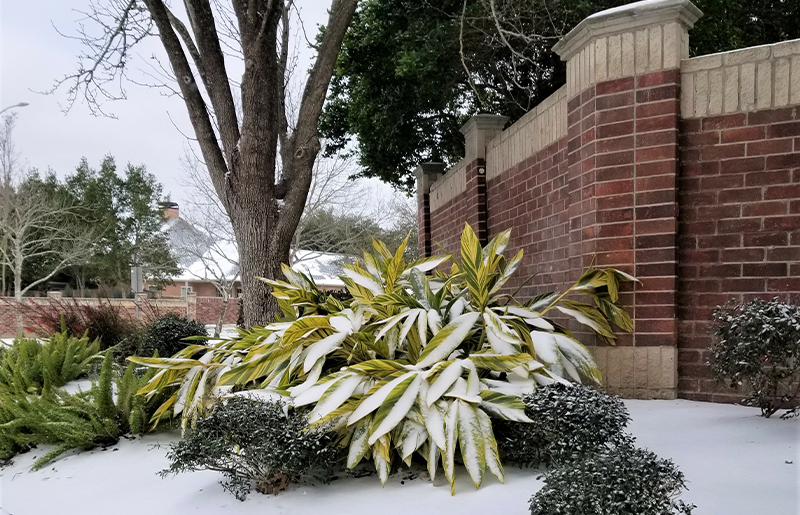
Protecting Trees in the Winter
by Terri Simon, Harris County Master Gardener
Trees can provide so many things for us at our home and in our garden. They can provide food, flowers, shade, insulation or color, adding value and beauty to your landscape. They reduce erosion and give us oxygen. Trees also offer a home for animals and plants. When I lived in Galveston a magnificent magnolia tree reached up to our second floor apartment. When it flowered I could open windows and the delicate scent wafted through our kitchen and bedroom. It was like having a natural deodorizer. Don’t forget trees can also have a recreational aspect. How many of us grew up swinging on a swing that was hung from a tree? I spent many childhood days reading my beloved books beneath the shade of a tree. Those were carefree days.
As fall approaches, now is the time to consider how to protect our trees against freezing weather. Fortunately, in this growing zone we do not have a lot of inclement weather, but we have had some surprises in the past few years. Earlier this year, several of my plants bit the dust because of a freeze I didn’t prepare for. I had already lost the few fruit trees due to Winter Storm Uri in February 2021. That four day freeze devastated plants and trees in many parts of the U.S. I lost trees and many plants as others gar- deners did. The freeze had no mercy. Even though I thought I had protected my trees and plants sufficiently, they died. Some died more slowly than others. I thought my precious Moro blood orange had been spared but I was wrong. It looked okay at first, but when all of the ice had melted it began oozing sap. I harvested over a 100 oranges from that tree, and I still miss it.
Stock up and prepare early for cold weather. If you wait until the last minute, the supplies you need may not be available. During Uri, I waited with several customers at a hardware store for a semi truck loaded with tubular foam pipe insulators that are put around pipes to prevent freezing. I bought the widest diameter (2”) they had for my pipes and my trees. The trunk of my Moro blood orange tree was wider than that so I sliced the pipes lengthwise and taped them together the best I could.
There are several things you can do to protect your trees. If they are in pots, move them to a protected area. All of my plants are on the south side of my house and the majority of them are in pots. I can move them next to the house for a little shelter if necessary. Brutal winter weather can cause severe damage to trees. This includes the wind as well. Winter wind can dry out foliage.
ICYMI: October Gardening TipsGet your garden in tip-top shape this month with gardening tips from a Harris County Master Gardener.
|
Snow and ice that accumulates can snap limbs or even knock down an entire tree. Another drawback to consider during the cold snaps- critters. Animals such as deer and rodents will nibble on your trees and plants since food is scarce. Sometimes you will find plants that are labeled as “deer proof”. An experienced woodsman once told me that was not correct. He said if a deer is hungry, they will eat literally anything. Fencing or another type of barrier can help keep them out, but not always. Repellents may also work.
Always water your plants well if a freeze is expected. If the soil is damp it can conserve heat loss better than dry soil. Don’t forget to mulch. Three to four inches of mulch is sufficient. Do not use colored or rubber mulch! Some gardeners pack the mulch all around including the trunk. If you mulch around the trunk be sure to move it away from the trunk as soon as possible. Our freezes usually don’t last long. In a pinch, use flattened cardboard instead of mulch but remove it as soon as possible.
You can save old bedding to cover trees with. Lightweight quilts and blankets can be used. Second hand stores may have covers at a discounted price. If you use fabric, then you should cover that completely with plastic sheeting so the covers don’t get wet. Burlap can be effective. Tree wraps are available at various local gardening stores, as well as online sites. Plant covers are also available, but know the approximate height and width of your tree before ordering. Secure the bottom of the covers with rope, twine or even bungee cords so they don’t get wet or blow away. Some gardeners use Christmas lights and entwine them in the tree for additional warmth. Warning: the LED Christmas lights do not gen- erate enough heat to protect your tree. The older traditional lights with the glass oval bulb do generate heat. One gardening couple I know in Pasadena had a large hoop house to store their 200+ plumerias. The plumerias were pulled from their pots in their garden and tossed in the hoop house during the winter. The hoop house was covered with large plastic sheeting during the winter and in the summer, once the plastic sheeting was removed, several of the larger plumerias were repotted and left in place. A small propane heater was used if the temperature dropped too low. A greenhouse is a good investment if your tree is small enough and is in a pot. The garage can work well also.
Whichever method you use to protect your trees and plants, make sure to monitor them and remove them as soon as possible. Since I lost many succulents a long time ago I always watch or lis- ten to the weather forecast. With some preparation and luck, your trees will be around for next spring.
Source:Harris County Master Gardeners Urban Dirt Newsletter (October 2023 Edition)
About Urban Dirt
Each month, Harris County Master Gardeners publishes an informative, resourceful newsletter entitled "Urban Dirt". This article was derived from the October 2023 edition. To read the October 2023 edition of this newsletter, click the button below.









